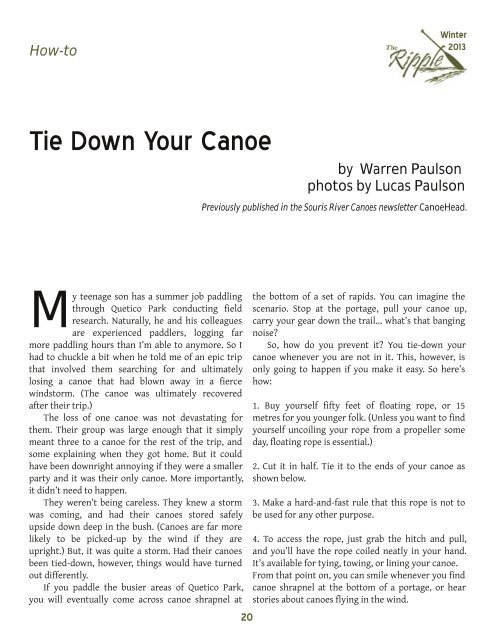Create successful ePaper yourself
Turn your PDF publications into a flip-book with our unique Google optimized e-Paper software.
How-to<br />
Tie Down Your Canoe<br />
My teenage son has a summer job paddling<br />
through Quetico Park conducting field<br />
research. Naturally, he and his colleagues<br />
are experienced paddlers, logging far<br />
more paddling hours than I’m able to anymore. So I<br />
had to chuckle a bit when he told me of an epic trip<br />
that involved them searching for and ultimately<br />
losing a canoe that had blown away in a fierce<br />
windstorm. (The canoe was ultimately recovered<br />
after their trip.)<br />
The loss of one canoe was not devastating for<br />
them. Their group was large enough that it simply<br />
meant three to a canoe for the rest of the trip, and<br />
some explaining when they got home. But it could<br />
have been downright annoying if they were a smaller<br />
party and it was their only canoe. More importantly,<br />
it didn’t need to happen.<br />
They weren’t being careless. They knew a storm<br />
was coming, and had their canoes stored safely<br />
upside down deep in the bush. (Canoes are far more<br />
likely to be picked-up by the wind if they are<br />
upright.) But, it was quite a storm. Had their canoes<br />
been tied-down, however, things would have turned<br />
out differently.<br />
If you paddle the busier areas of Quetico Park,<br />
you will eventually come across canoe shrapnel at<br />
20<br />
<strong>Winter</strong><br />
<strong>2013</strong><br />
by Warren Paulson<br />
photos by Lucas Paulson<br />
Previously published in the Souris River Canoes newsletter CanoeHead.<br />
the bottom of a set of rapids. You can imagine the<br />
scenario. Stop at the portage, pull your canoe up,<br />
carry your gear down the trail... what’s that banging<br />
noise?<br />
So, how do you prevent it? You tie-down your<br />
canoe whenever you are not in it. This, however, is<br />
only going to happen if you make it easy. So here’s<br />
how:<br />
1. Buy yourself fifty feet of floating rope, or 15<br />
metres for you younger folk. (Unless you want to find<br />
yourself uncoiling your rope from a propeller some<br />
day, floating rope is essential.)<br />
2. Cut it in half. Tie it to the ends of your canoe as<br />
shown below.<br />
3. Make a hard-and-fast rule that this rope is not to<br />
be used for any other purpose.<br />
4. To access the rope, just grab the hitch and pull,<br />
and you’ll have the rope coiled neatly in your hand.<br />
It’s available for tying, towing, or lining your canoe.<br />
From that point on, you can smile whenever you find<br />
canoe shrapnel at the bottom of a portage, or hear<br />
stories about canoes flying in the wind.


